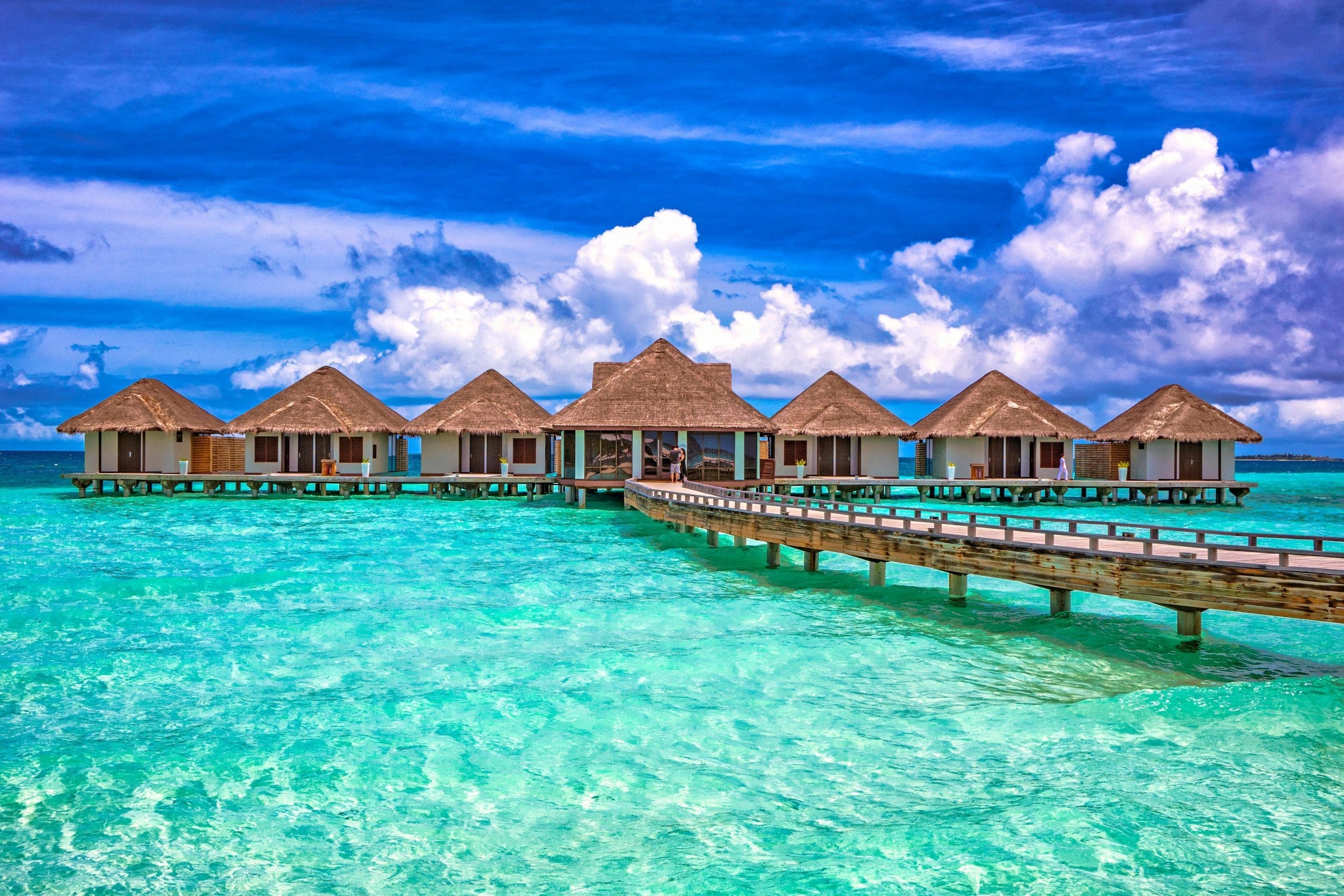INTRODUCTION

Maldives has been inhabited for more than 400 years and was known to have traded with cowry shells as far back as the Indus Valley Civilization. It is an island nation situated in the Arabian Sea of the Indian Ocean, formed by a chain of 1,900 coral islands grouped into 26 atolls southwest of Sri Lanka and India, about 700 kilometres (430 mi) from the Asian continent’s mainland. The chain of 26 atolls stretches from Ihavandhippolhu Atoll in the north to Addu Atoll in the south to the equator. Comprising a territory spanning roughly 298 square kilometres (115 sq mi), the Maldives is one of the most geographically dispersed sovereign stated as well as the smallest Asian country by land area and population with around 515,696 inhabitants. Malé is the capital and the most populated city, traditionally called the “King’s Island” where the ancient royal dynasties ruled for its central location.
The government system is republic, the chief of state and head of government is the president. Maldives has a mixed economic system which includes a variety of business and fiscal freedom, combined with centralized economic planning and government regulation. Maldives is a member of the South Asian association for Regional Cooperation (SAARC).
It has a culture that evolved through its survival in the middle of the ocean and its interactions with the cultures across the oceans. From the beginning Maldives has been a melting pot of many cultures from the Indian Ocean. Its cultural heritage consists of an intangible heritage based on the unique language performing arts, arts and crafts, cuisine and a tangible heritage based on its maritime heritage and architectural heritage from pre-Islamic and Islamic periods.
The Maldivian craftsmanship and skills were admired from a very early period. The coir rope, a handmade product from coconut fibre was mentioned by early travellers and scholars of the region. Lacquer work; Liye laajehun, mat weaving; Thundu kunaa, embroidery; Kasabu work and weaving are famous Maldivian crafts. Products from weaving and plaiting of coconut leaf are also important crafts and their products like thatching and woven baskets; Mulhi and Gonu were used in everyday life.
ARCHITECTURAL HERITAGE

Marriott International Hotel
Developing countries like Maldives often reject cultural heritage in the wake of globalization and fast development as a symbol of backwardness but as they progress they start to revive what is left of it. Similarly, since the 1960s, Maldives has been developing and transforming at a fast pace and its architectural heritage started vanishing fast. The architectural heritage, that include the traditional island settlements, traditional buildings, traditional building methods and materials are changing and replaced by modern structures and materials. But after the introduction of tourism in 1972 the architecture of the tourist resort emerged and with it came, to some extent, a renewed appreciation and adaptation of traditional building methods and materials. Today tourism master plans argue that cultural heritage tourism could be promoted along with the key attractions of sun, sand and sea. Typical features are bungalows which are built above the sea water and connected with each other. Spa and wellness areas with Far Eastern characteristics complete the main codes of Maldivian architecture. The Spa blocks are an example for this natural material use concept.
The traditional settlements include the traditional island settlements and architectural heritage of Male, which has almost disappeared. The traditional building includes the structures within the traditional house compound, the traditional mosques, structures for special purpose and pavilions.
- Traditional settlements
The traditional islands are built natural landscapes that illustrate a traditional way of life, evolving over hundreds of years through harmonious interaction between people and nature. They are low lying coral islands, surrounded by a reef that is breached in a few places to allow access to the island by boats. The main buildings of the island include the traditional houses, the mosques, pavilions and Haruge’; structures for special purposes. Male’ is the capital of Maldives with history of more than 900 years but today it is heavily built up and densely populated and its architectural heritage is hardly visible. Male’ was the centre of the 800-year-old sultanate where sultans rule the country from the main palace. During that time, it was a walled city with bastions, gates, palaces, great mosques, bazaars and harbours. Unfortunately, what is left of old Male’ are few mosques and buildings. Male’ old Friday mosques is most important architectural heritage of the country.
- Traditional buildings
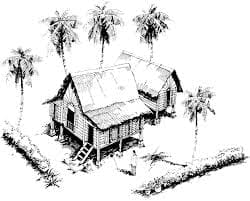
The traditional houses with its compound have most to contribute to the architectural heritage but they do not survive due to the type of materials used in construction. The traditional house compound; Goathi is the extension of the traditional house; main house, Badhige’; kitchen, Koshaaru; granary, Valhu; well and Gifili; an open-air toilet area and sometimes ‘Undhoalige’; swing house.
It offers an indoor-outdoor lifestyle that is common to many tropical countries. Most daytime activities take place in the compound under the shade of the large trees or semi outdoor spaces like the veranda; ‘Fenda’ of the house or Undhoalige’. The main house is the central element in the compound. It primarily comprises of Beyruge’; outer chamber and Etherege’; inner chamber. The outer chamber is the area for men and children. Two platforms; Bodu ashi and Kuda ashi, a coir rope strung bed and big wooden chests are common furniture in the outer chamber. The inner chamber with two beds referred as north bed and south bed is the domain of the women.
The house has two entrances from the outer chamber giving access to the front and the back of the compound. The kitchen stands totally separate from the main house and granary. With no chimneys, smoke extraction and ventilation was often through perforated walls that are made out of coconut fronds; Fanthoshi. Wooden trellis was placed above the hearth for drying fish and walls were sometimes lined with open shelves for cooking utensils and it has a thick plaited thatched roof sheltering it from the rain.The water wells located near the kitchen and open-air toilet are used for bathing, washing and cleaning fish. These shallow water wells are an important component of a house.
The traditional mosques are the oldest architectural heritage in the country. Today four types of traditional mosques survive. They are built between 14th century and 20th century and are categorized by their use of material and type of construction. They are as follows:
- Mosques using Veligaa or coral sand stone masonry construction technique. An example of this type of mosque is Gen Miskiy in Fuvahmulah. The date of construction is unclear but believed to be built in the 1400s.
- Mosques using both Veligaa or sand stone and Hiriga or coral stone masonry construction technique. Typical example of such a mosque is Vadhoo old Friday mosque believed to be built in late 1500s.
- Mosques using Hiriga or Porite coral stone “carpentry” construction technique. Examples of this type of mosques are Male’ Old Friday Mosque built in 1657, Male’ Eid Mosque built in 1815 and Fenfushi Old Friday Mosque built in 1695.
- Mosques using chipped coral rubble masonry for construction. Examples of this type of mosques are Male’ Bihuroazu Kamana Miskiy rebuilt in 1919.
The traditional mosque is also set within a mosque compound with water wells, a sundial dial, cemetery and occasionally small minarets and bathing tanks. The typical mosque has a rectangular prayer hall and a combination of the veranda like antechambers called Dhaala/Fenda and occasional Mihrab chambers. It is built on a raised plinth and entered through rising stairs from the eastern side. On both sides of the stairs are timber ledges, which are used as seating for the elderly and the disabled. The roof form is tiered, hipped and steeply sloped with large overhangs and are finished with plaited coconut thatching, clay roofing tiles or metal roofing sheets. All mosques have a timber coffered ceiling and many with a central stepped recessed area called Laage’. The window openings have diagonal lattice timberwork called Miskthu Jaali. The types of doors vary depending on the type of traditional mosques but mostly have sliding doors. The iconography of decoration is based on organic and geometric patterns with calligraphic writings from the Quran in Thuluth Arabic script. Boundary walls and entrance gates are occasionally found in mosques located in populated areas. The landscaping with paths leading to the mosque building and wells are neatly laid with white sand and special plants like Jasmine and Basil. The beach pavilions; ‘Holhu ashi’ are the most popular type of pavilions in Maldives and are still found throughout the country. They are raised platforms, often with a roof above. The posts and platforms are usually made from screw pine trunks and the roof is made from coconut thatch. Other pavilions include ‘Ashige’; a meeting place inside islands often used for prayers by women or elders, ‘Maizan’; public meeting pavilions, ‘Mariyaadhuge’; a formal meeting pavilions in palaces and stately houses. The structures for special purposes include boat houses; odi/dhoni haruge’, permanent and temporary structures build for functions, recitals, education etc. They include recital halls; ‘Mauloodh haruge’ and schools; ‘Edhuruge’. These structures are usually simple structures built with timber frames and coconut thatched walls and roof.
- Architectural Development of Tourist
Use of traditional architectural forms in the resorts:
- Traditional islands: The traditional island forms or layouts are not used in the resort architecture. However, many elements of the traditional island are used. The most commonly used element is the traditional jetty. Many resorts of the early phases had jetties built in the traditional manner. Examples are found in Club Med Faru, Baros Holiday resort, Alimatha Aquatic Resort and Rihiveli Beach Resort.
- Traditional house: The traditional house form is often adapted and used in many resort of phase one, two and three. The concept of open-air toilet comes from the traditional Gifili. The hammock type of chair is commonly used. Examples are found in Rihiveli Beach Resort, Ari Beach Resort and Kandoomaa Island Resort.
- Traditional mosque: The form of the traditional mosques is not used in resort architecture however many detailing such as the plinth moulding shapes, are reinterpreted and used in contemporary manner among the decorations of a few resorts from phase three. Examples are Reethi Beach Resort. The coral carvings designs and details are often found in many interior designs as decorative elements.
- Beach pavilions and Haruge: The forms and details of beach pavilions and Haruge are often used in the architecture of the resort. They are of course reinterpreted and modified to suit the needs of the resorts. Raised platforms are not common but the A-frame shape of boathouses was used many times in resort architecture. Examples can be found in the second face structures of Ari Beach Resort built in the early 1990s.
Use of traditional building methods and materials in the resorts
- Thatched construction: Coconut thatching is the most popular form of roof construction in resorts construction. It was also used in the wall panelling of the early resorts. It is still found in interior decorations. Coconut thatching is an important renewable and ecologically sound local material that blends well with the natural environment of Maldives. It is an important local industry that is sustained because of the tourist industry.
- Timber components: Local timbers are no longer used because of the limitations in availability. Traditional methods of panelling and use of round timber was popular in the early phases of resorts like Rihiveli Beach Resort. Nevertheless, timber panelling is popular in resort constructions but traditional methods are hardly seen now.
- Coral stone construction: Coral-stone walls were common in the early resort construction however since the ban on coral stone mining in 1992 the new resorts do not use coral stone. Coral stone construction is no longer possible in Maldives but still recycled stone are selectively used indoors and outdoors in some of the resorts like Four Seasons Landa Giraavaru.
- Marine structures: Reinterpretation of maritime themes can be seen among some of the resorts. Example traditional boats and its details are applied in the design of water bungalows. Wooden timber decks are also built taking advantage of boatbuilding techniques. Some of the themes can be observed in Cocoa Island (Makunufushi) upgraded, Hakura Club and Ari Beach resort.
MALDIVIAN LANGUAGE

The Maldives has an incredibly rich and diverse history that has been influenced by many cultures over the years. The language is the prime example of this. Dhivehi is the national language of the Maldives, which is sometimes referred to as Maldivian and has been shaped by various languages including Arabic, French, Portuguese, Persian and English.
Dhivehi is an Indo-Aryan language derived from the Sinhalese language of Sri Lanka. Despite the countries’ close proximity to one another, Maldivians and Sri Lankans do not always understand each other.
While Dhivehi is the national language of the Maldives, many Maldivians also speak and understand English, French, German, Russian, Italian and Chinese which are also widely used at the resorts.
FESTIVALS OF MALDIVES
Every event be it national occasion or spiritual festivals, it is celebrated with the very same enthusiasm with natives from all walks of life contributing in the celebrations. A sense of unity is visualized from these enthusiastic celebrations. Given that the majority of peoples in Maldives are Muslim, Muslim Religious festivals reveal dominance among st the Festivals of Maldives. They are celebrated in accordance with the lunar calendar.
- Ramadan

Ramadan falls on the ninth month of the Islamic or the Lunar calendar during which the Muslims observe fasting, prayer, reflection and charity for 30 days. The last third of Ramadan is considered even more auspicious as it is believed to be the time when Korans (Quran) first verses were revealed to the Prophet Muhammad.
A majority of the population in the Maldives being Muslim, the government offices work only between 9 am to 1.30 pm. Many of the private workplaces close by 3 pm in the afternoon. Meanwhile, resorts and hotels are not affected by the holy month. In fact, this is one of the best times to visit the Maldives, as you get to taste a lot of cultural foods that are exclusive to this festival. Many restaurants also offer special Iftar (evening meal for breaking the fast) meals on their menu. Try some Ramadan juices in exotic flavours of rose, apricot, and kamardine. The celebration also involves cultural activities like performances by music bands, belly dancers and fire dancers.
- National day
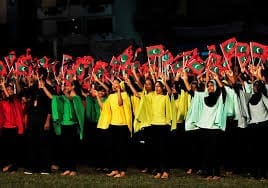
National Day of Maldives, officially known as Qaumee Dhuvas, is observed to honor the day when a local revolt forced the colonial Portuguese to leave the land. In 1558, the Portuguese arrived in Maldives, killed the local sultan, and taken over. In 1573, however, Muhammad Thakurufaanu and his forces took back Male and ended the 15 long Portugal rule. However, it was later colonized by the Dutch and the British.
National Day falls on the 1st day of the month of Rabee-ul-Awwal (3rd month) of the Islamic Calendar. On this day, numerous military parades, political speeches, flag-raising ceremonies, are held across the island nation. You may also see fireworks in some places.
- Freedom day

Maldives celebrates its complete independence on July 26th. The celebrations see parades held by the National Security Services and National Cadet Corps. There are also performances by school children.
Maldives used to be British colony and in 1887, t received the status of a British Protectorate, which freed the country from interventions into its internal affairs. But the foreign affairs were still controlled by the British, in return of which British were to give them protection. Finally, on July 26th, 1965, Maldives gained complete independence. Interestingly, when the then Prime Minister, Ibrahim Nasir, had signed the agreement with the British for independence, the population in Maldives was merely 97,743.
- Republic Day

Maldives celebrates Republic Day on November 11th to commemorate the replacement of the prolonged Sultanate rule with a republican form of government in 1968. It is also the day on which a new Maldivian president is appointed, once in 5 years. As a part of the celebration, official events held all over the country, including speeches and parades. This is the best time to taste some special Republic Day foods like huni hakuru folhi, a kind of coconut cake; bodibaiy, a super-sweet rice snack; and masroshi, a sort of fish-stuffed pancake.
Within a few years of independence, a referendum was held on March 15th 1968, in which 81% of the people voted to replace the Sultanate with a republic. On November 11th, 1968, the republic was officially pronounced. Ibrahim Nasir, the final sultans Prime Minister, became the first president of the modern Republic of the Maldives.
- Prophet’s Birthday

Mawlid (Mawlid un-Nabi) meaning the birth of the Prophet, is celebrated as the birthday of the founder of the Islamic faith, Prophet Muhammad. It is observed in the month of Rabee-ul-Awwal (3rd month) in the lunar calendar. The Sunni Muslims celebrate it on the 12th day, whereas the Shia Muslims recognize it on the 17th day.
Mawlid is celebrated in a carnival-style, with a large street procession and decorating the mosque. As an expression of love towards the Prophet, scholars, and poets recite famous Sufi poems. Stories about the life of Muhammad are also recited at the community gatherings. The day is completed by donating food and money to the poor, as a charity. If you’re looking to witness one of the most splendid Maldives famous festivals, then surely this one is your pick!
- Eid Festival

For the best feast of the year, the Eid Festival is the place to be. Held at the end of Ramadan in the month of September, Eid is a fantastic time to explore the cultural splendours of the Maldives’ religious faith. The event generally lasts for about 3 days, where grand meals are prepared across the country.
MALDIVAIN FOOD
Traditional Maldivian cuisine, also known as Dhivehi cuisine, provides a wonderful variety of tastes and flavours, ranging from crunchy snacks and street foods accompanied by wood-fired chapatti bread to complex and deliciously spicy curries.
The cuisine of the Maldives is a rich assemblage of traditional flavours with strong influences from its neighbouring countries, such as India and Sri Lanka. In the past, Maldivians depended on essential ingredients such as fish, coconuts, breadfruit, millet and tubers, and over time, with the influence of foreigners from ancient trade and travel, Maldivian cuisine developed a distinctive blend with its own unique flavours, symbolizing a unique culinary identity.
Today, traditional Maldivian cuisine is based on three main ingredients and their derivatives, namely coconut, fish, and starches containing grains and vegetables. The delicious food boasts a distinct tang made up of mild spiciness, delicate sweetness, and an overall exotic taste, and is prepared using ancient cooking traditions that have been passed down through the generations.
- Coconut

Coconuts, called ‘kurumba’ in Dhivehi, are grown on every island in the Maldives and are such a vital part of the culture and cuisine that the coconut palm has been declared the country’s national tree. One of the main ingredients in Maldivian cuisine, the coconut is used in a variety of forms from grated and shaved to a liquid form such as coconut milk, and as oil in dishes that are deep-fried.
Coconut is grated with a traditional Maldivian implement known as the ‘hunigondi’- a long low chair with a serrated steel blade at its end that shreds the coconut into a bowl below the blade. The grated coconut can be used as is, or soaked in water and squeezed to obtain coconut milk (kaashi kiru). Coconut milk is an essential ingredient in many Maldivian curries and other dishes, and also used in a variety of fruit-based beverages and ‘mock tails.’
- Fish
It’s not surprising that fish is the star ingredient in the ocean-bound island nation’s cuisine, with tuna being the king. The Maldives is home to a variety of tuna species, namely frigate tuna (raagondi), little tunny (latti), skipjack tuna, and yellowfin tuna (kanneli), which is used in many dishes either dried or fresh. Other popular fish species also used include bigeye scad (mushimas), mahi-mahi (fiyala), mackerel scad (rimmas), and wahoo (kurumas), which can be eaten boiled or processed.
Tuna is prepared cooked, cured, smoked or sundried, while other fish are typically grilled or deep-fried. Processed tuna, also known as Maldive fish, is used as pieces or as shavings and dry-processed, and tuna curries use raw or still-soft processed tuna cut into small sections. Tuna is also used to make snacks or ‘short eats’ known as bajiya (the local version of the Indian samosa), kulhi bōkiba, fatafolhi, kavaabu, gulha, and masroshi. Mas huni is a traditional Maldivian breakfast item made from dry processed tuna mixed with coconut, onions, and chili. Another vital ingredient in Maldivian cuisine is the tuna-based thick brown paste known as rihaakuru.
• Starches
Starches are a staple in Maldivian cuisine and are used in a variety of forms, including tubers such as cassava (dandialuvi), sweet potato (kattala), and taro (ala); fruits like breadfruit (bambukeyo) or screwpine (kashikeyo); and rice, which is ground into flour or eaten boiled. Tubers and breadfruit are also eaten boiled, while the screwpine fruit is mostly eaten raw after having been cut into thin slices.
- Curries

Curries are one of the most popular dishes in Maldivian cuisine and vary from fish and chicken curries to vegetable curries, rich with spices and exotic flavors. Top of the curry dishes is Mas Riha, which is made with diced fresh tuna, coconut, peppers, and plenty of fresh chilies, while a chicken curry known as Kukulhu Riha is also a favorite filled with a different mixture of spices.
Vegetable curries are also on the menu and include delicious non-meat ingredients such as eggplant (bashi), pumpkin (barabō), tora, chichanda, and muranga, as well as unripe green banana, coconut milk and a curry paste blended with onions, herbs, spices and chili peppers. Curries are usually eaten with steamed rice or with roshi or chapati (unleavened flatbread).
- Maldivain Speciality

Maldivian cuisine also features a variety of delectable specialty dishes, prepared with fresh fish, chicken and meat, and fresh local fruits and vegetables.
- Mas huniis a famous tuna salad with coconut that is traditionally eaten for breakfast with chapati bread. The fresh, spicy dish is made with tuna, coconut, chili, and onion, blended, seasoned and served with chapati bread.
- Garudhiya(Maldivian fish soup) is a favorite dish eaten by Maldivians almost every day. Served hot with rice, lime and plenty of chilies, the soup is packed with fresh raw tuna and chopped chili, with a dash of lime.
- Kulhi boakibaor fish cakes have been eaten by Maldivians for thousands of years, particularly on special occasions like festivals and feasts. Prepared with smoked tuna, grated coconut, chopped chili peppers, ginger and rice, the fish cake is also eaten as a short-eat during evening tea.
- Handulu Bondibai(sweetened sticky rice) is a unique dessert made for extra special occasions like the birth of a child. Eaten with ‘kulhimas’ or ‘bondibai’ (breadfruit, sago or rice parcels), this sweetened sticky rice dish is distributed to all households in the islands.
- Street Food

The small, motorcycle-packed lanes of Malé are lined with tiny roadside eateries and bustling markets that serve a variety of mouthwatering street food and local delicacies such as bajiya – a sweet pastry stuffed with fish, coconut and onions; kulhi borkibaa – spicy fish cakes; gulha – sweet pastry balls filled with smoked fish; theluli mas – fried fish with chili and garlic; and kavaabu – deep-fried snacks made from rice, tuna, coconut, lentils and spices.
ETHNIC GROUPS

The population of Maldives belongs almost entirely to the Maldivian ethnic group, which is the result of various peoples settling in the islands successively through the country’s history. The first settlers, it is generally believed, were Tamil and Sinhalese peoples from southern India and Sri Lanka. Traders from Arab countries, Malaya, Madagascar, Indonesia, and China visited the islands through the centuries. The official language is an Indo-European language called Dhivehi (or Maldivian); Arabic, Hindi, and English are also spoken. Islam is the state religion.
TRADITIONAL CLOTHING OF MALDIVES
India’s strength lies in its diversity, multiplicity, and ethnicity. Every region of India has its very own lingual and traditional culture. The Maldives is no exception. The Maldives inherited parts of the Arabic, Indian and Sri Lankan culture but retained a unique blend of all. They do reflect much of their customs and traditions. This can be seen in the way they dress. Their apparels are diverse with combinations of different cultures clubbed into one island. The Maldives is a great tourist magnet impresses a lot of the tourists with their traditional costumes.
• Women’s Traditional Dress of Maldives
- Dhivehi Libaas


Dhivehi Libaas, the traditional Maldives dress adorned by women is unique to the island boasting its embroidery techniques. It is all about highlighting the embroideries which are called Kasabu Viyun. They usually surround the neckline or sometimes on the dress borders. They are undoubtedly beautiful designs. They look best when weaved on bright fabrics. There are kurtas and long dresses which behold the embroideries. Kasabu viyun is nothing but gold and silver laced weavings pasted on a patch of clothing attached to Dhivehi Libaas.
One can see these traditional dresses of Maldives being widely worn in local islands and the city of Male. Dhivehi libaas is worn with an underskirt called feyli. It is best matched with it. Feyli is black or dark blue wrap-around which has a border at the bottom with different types of stripes. With the evolution of this piece of apparel, the original black lines have been replaced by gold and silver to match best with the libaas.
These dresses are widely worn during ceremonial occasions and dance performances. Dhivehi libaas is a little difficult to purchase as you have to get it tailored, but you can find it at some traditional dress shops and souvenir shops of Maldives.
2. Dhigu Hedhun
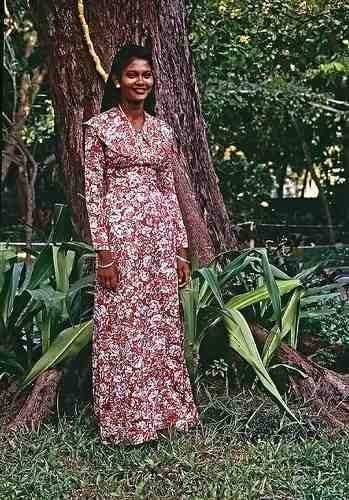
Also treated as the national dress of Maldives, it serves an essential purpose in representing the island’s identity. This apparel is gown made with lace. It is elegant, made to fit the body contours well. The charm of the outfit lies in the elegance it reflects when it is worn. It is a lace creation, but with evolution, other textiles are also used. They are worn at important occasions such as formal and national functions. However, simpler versions of it are worn regularly by traditional ladies of the island. They are not as elaborate as the party Dhigu Hedhun outfits. They are worn along with minimal ornaments.
3. Hedhun Buri

Another traditional dress of Maldives is the Hedhun Buri. It was a daily-wear outfit in the earlier era. The young women of Maldives commonly wear this dress, especially on festivals and dance programs. The costume consists of long shimmery jacquard blouses with wrap-around skirts to pair with. They often come with head-bands matching with blouses. The attire is classy and beautiful. The skirts are worn with matching coloured skirts. It is an accurate representation of the Maldivian tradition. The outfits are rare to find, and if you get a hold of them, they are usually available in souvenir shops, or you have to get it tailor-made.
4. Burqa
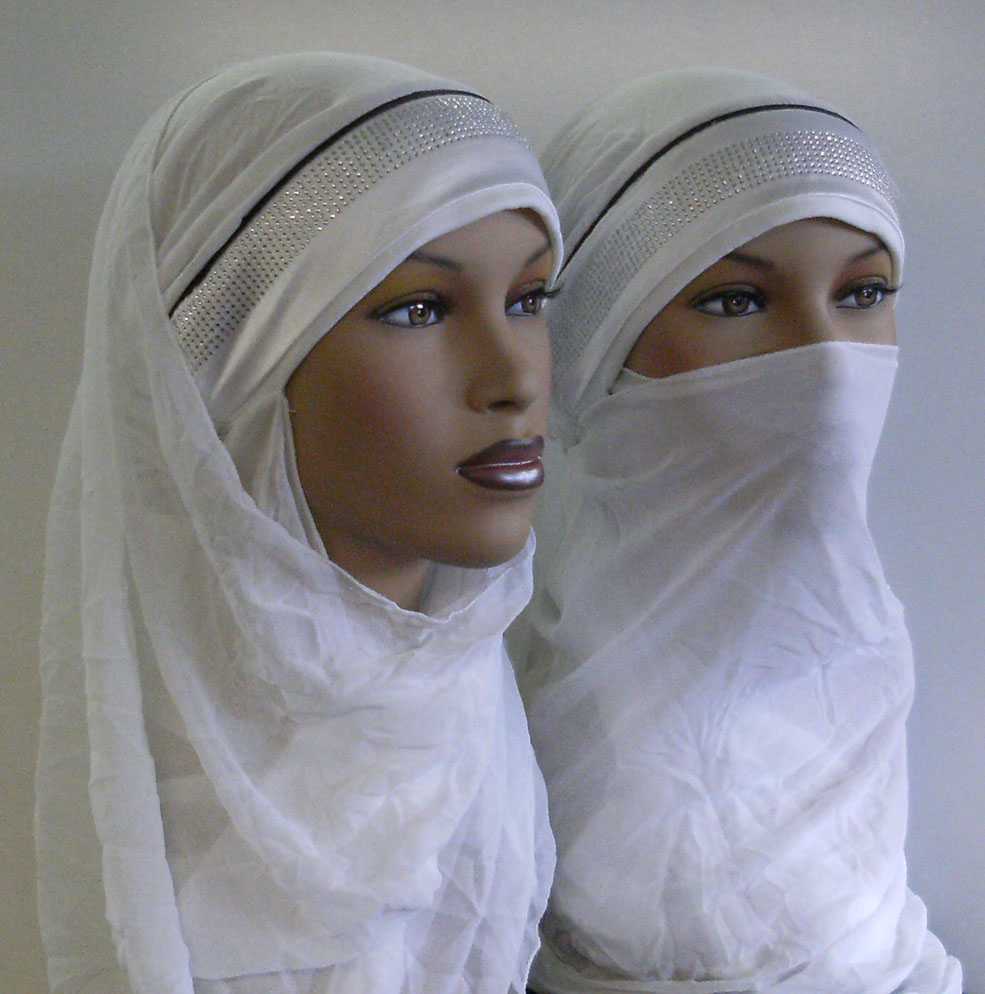
Due to Arabic influence in Maldives, women wear black robes and headscarves. They are worn mainly by their community, and one can identify them by their attire. It is out of religious respect that women continue to wear black robes and cover their heads. Not all those who wore Burqas adhered to the etiquette that went along with the traditional attire. They are worn with evolved and fashionable robes and scarves.
• Men’s Traditional Dresses of Maldives
5. Sarungan
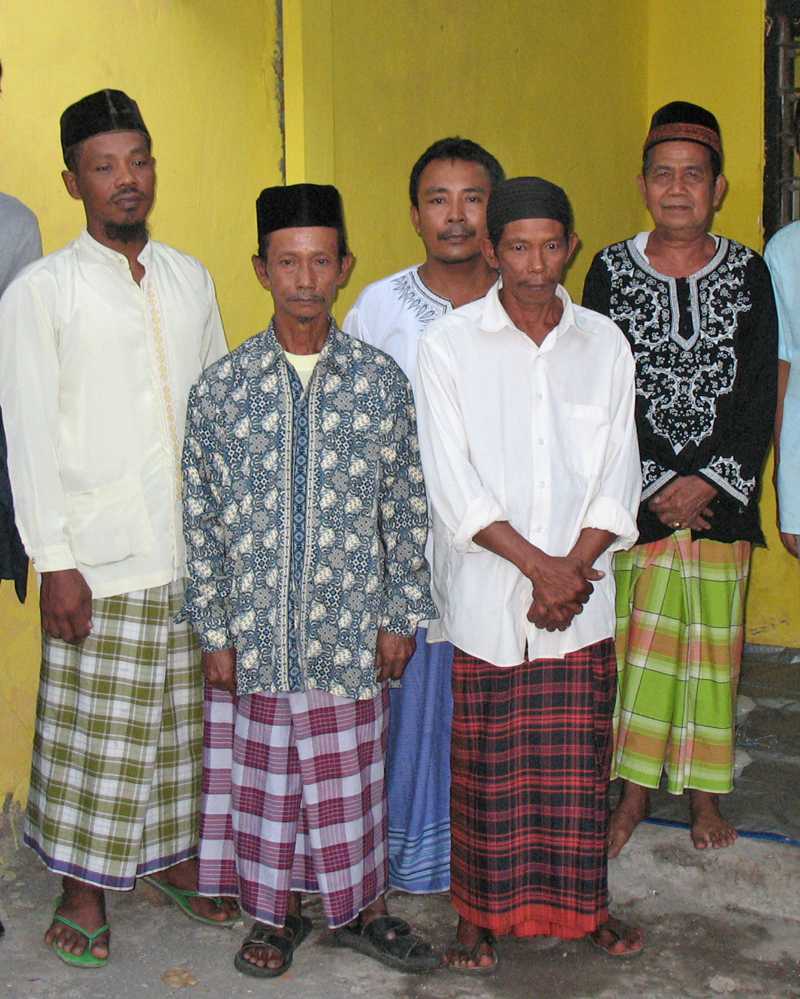
Men’s traditional dress of Maldives are simpler. They form the very beginning sported Sarungan which are long clothing wrapped around their waist. They are usually black with white stripes. They are very similar to Feyli- that which is worn under Dhivehi Libaas. It is matched with either a white long or short-sleeved shirt. The men usually wore this simple attire, mostly weaved in cotton fabrics. The Sarungans are smart, and light wears clothing piece.
Along with Sarungan, they usually wrapped their heads at times to cover their heads, either out of religious culture or to keep their heads protected from the scorching heat.
These traditional dresses of Maldives uphold Maldivian culture and customs. It is a true reflection of their history and traditions. It is sporadic that the attires have carried forward since aeons and stayed close to the hearts of the people. If you take a trip to this eye-catching and spell-bounding island, make sure to get your hands on their traditional dresses and take back home some as souvenirs and keepsakes for yourself. You are bound to look charming after wearing these outfits. Don’t miss out on them!
Reference:
Culture of the Maldives. (2020, May 20). Retrieved August 06, 2020, from https://en.wikipedia.org/wiki/Culture_of_the_Maldives
Maldives: Introduction. (n.d.). Retrieved August 06, 2020, from https://globaledge.msu.edu/countries/maldives
Holidify. (2020, January 25). Traditional Dress of Maldives – 5 Local Traditional Maldives Dresses. Retrieved August 06, 2020, from https://www.holidify.com/pages/traditional-dress-of-maldives-2729.html
Asia. (n.d.). Retrieved August 06, 2020, from https://www.travelonline.com/maldives/language
Mia, Melanie, & Stormen. (2019, January 02). Traditional Maldivian Cuisine. Retrieved August 06, 2020, from https://www.themaldivesexpert.com/1659/traditional-maldivian-cuisine/
Swantour. (2019, October 04). Festivals of Maldives: Religious Festivals& Culture – Swan Tours. Retrieved August 06, 2020, from https://www.swantour.com/blogs/festivals-of-maldives/
Elin P. BabyA writer at TravelTriangle. (2020, May 11). Plan Your 2020 Maldives Trip Around These 9 Festivals To Add More Essence To Your Vacation. Retrieved August 06, 2020, from https://traveltriangle.com/blog/maldives-festivals/
The Editors of Encyclopaedia Britannica. (2020, May 21). Maldives. Retrieved August 06, 2020, from https://www.britannica.com/place/Maldives

